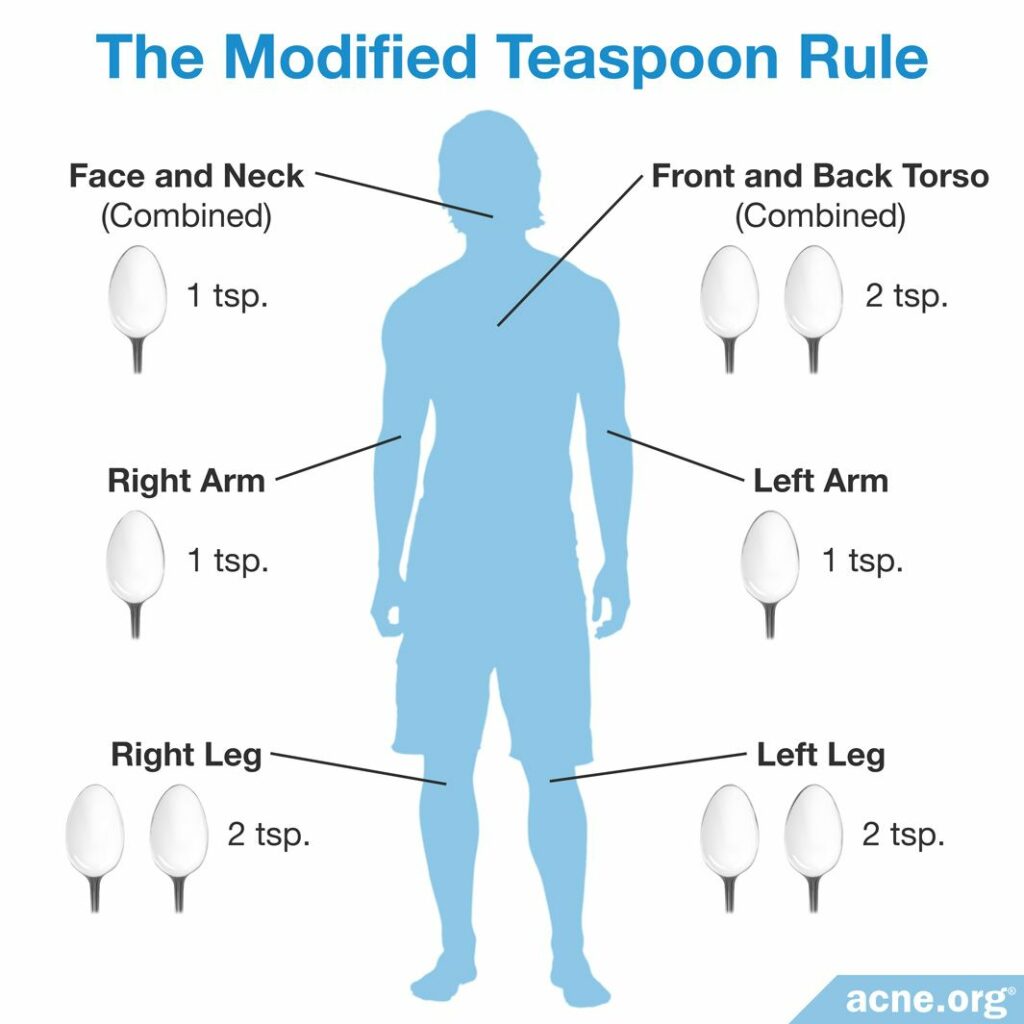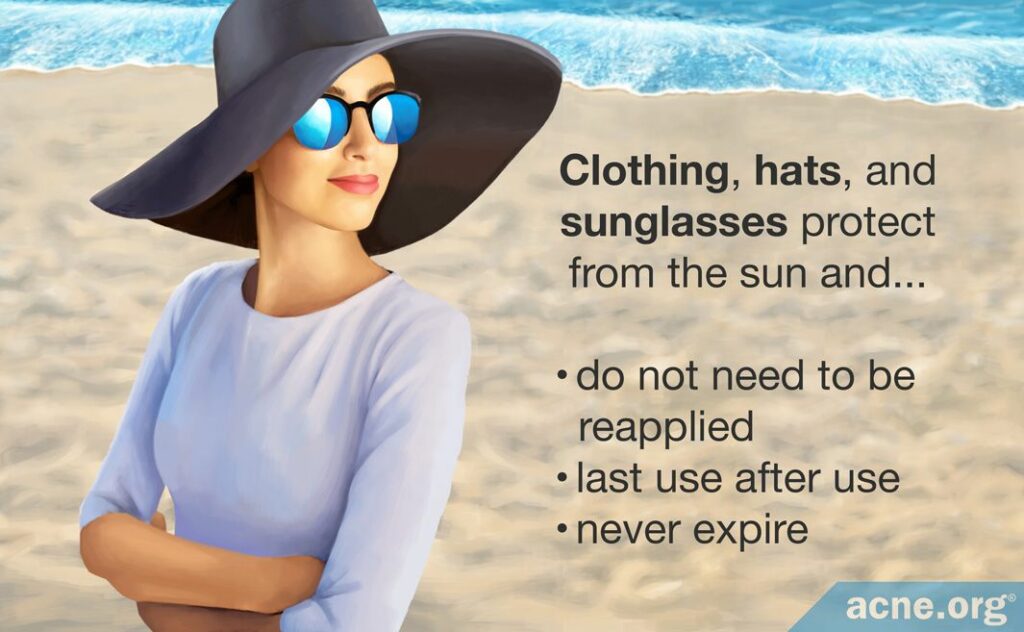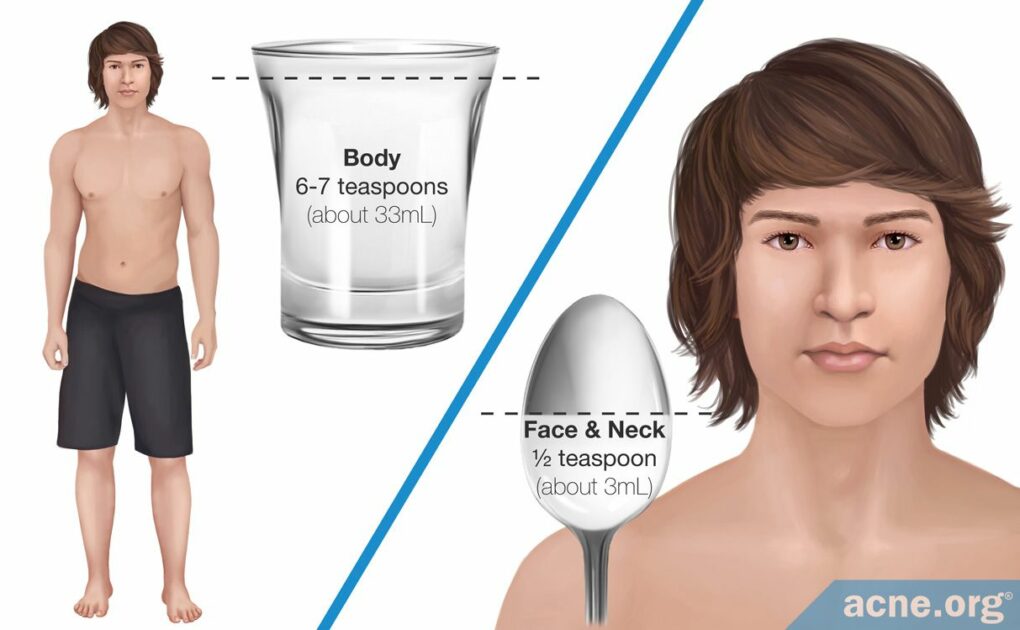It’s More than You Think. People Generally Use Only 1/4 of What Is Recommended.

The Essential Info
Sunscreens are tested using a generous coating on the skin, but the typical person applies just a fraction of this.
To make sure you are using enough, apply ½ teaspoon (about a quarter-size amount) to your face and neck every 2 hours that you are in the sun, and 6-7 teaspoons (equivalent to a shot glass), to your entire body.
The way most sunscreens protect is by absorbing the sun’s rays, and after 2 hours of sun exposure, most sunscreens are “used up” and no longer able to do their job. This is why it is important to reapply sunscreen after 2 hours of sun exposure. That doesn’t mean you have to reapply every 2 hours throughout the day even if you aren’t in the sun. It just means after two hours that your skin has been directly in the sun.
If you end up toweling off, and rub the sunscreen off your skin, you’ll need to reapply immediately as well.
How I Do It: I put on some sunscreen any day that it’s going to be sunny, except for in winter. I don’t follow the teaspoon rules that they give you. Instead, I just make sure I use plenty. I opt for SPF 15 – 30 because high SPF sunscreens have broken me out in the past, and they don’t provide that much more protection than the SPF 15 – 30 ones.

The Science
- How Much To Use
- Sun protection for the lips
- Why Too Little Sunscreen Is a Problem
- SPF Explained
- Things to Be Aware of with SPF
- Other Reasons Why You Might Not Be Protected
Your skin is the largest organ in your body, and it is directly exposed to the sun’s ultraviolet (UV) rays, so it is important to do what you can to shield against damage.1 Sunscreen can help, but for the most part, people do not apply enough–far less than they need to get the protection advertised on the label–and they forget to reapply.
How Much To Use
The recommended dose of sunscreen is 2 milligrams per square centimeter of exposed skin. You don’t need to memorize that, but at this concentration, that means the average adult needs a little more than a ½ teaspoon (3mL) to cover their face and neck, and 6 or 7 teaspoons (33mL) to cover their entire body. That can be hard to wrap your brain around, so healthcare providers developed the so-called teaspoon rule.2,3
The Teaspoon Rule
- Use about ½ tsp. (3mL) on:
– Face and neck combined
– Each arm - Use about 1 tsp. (6mL) on:
– Chest and abdomen combined
– Back
– Each leg
Even this rule was hard for people to follow, and most people ended up applying much less sunscreen than this.4,5 Studies have found that people typically use just ¼ (0.5mg/cm) of what they should.2,3,6
As a result, healthcare providers revised this rule to make it easier for people to remember. I know, by now you’re probably like, just tell me how much to use! But it’s good to hear it a few times, and hear the history behind it so it really sinks in.
The Modified Teaspoon Rule

This rule ups the volume to a full teaspoon on the face, and 9 teaspoons–roughly the contents of a shot glass or the size of a golf ball–across the entire body, distributed as follows:3
- 1 tsp. on:
– Face and neck combined
– Each arm - 2 tsp. on:
– Torso, front and back combined
– Each leg
With this modified teaspoon rule, you’ll definitely be applying plenty.
The way I like to look at it: All these “teaspoon” rules can get a little complex for me. When I’m applying I just think to myself, “Use a generous amount. Get a good coating on there.” It doesn’t have to be that complicated.
Sun protection for the lips
The skin of the lips also needs sun protection, so look for a lip balm with a broad-spectrum sunscreen incorporated into it. One study suggests that it’s ideal to apply sunscreen-containing lip balm to the lips 2 – 3 times a day when you are out in the sun.7
Why Too Little Sunscreen Is a Problem
Sun exposure is not all bad. Our bodies use ultraviolet (UV) radiation to make vitamin D, a hormone important for absorbing calcium from the gut and keeping our bones strong. Vitamin D is also vital for wound healing, and since acne lesions are wounds, getting the proper amount of vitamin D could potentially help heal acne more quickly.
However, getting too much sun has major downsides. A sunburn is skin damage, and anything that damages the skin can bite back with acne in the weeks following over-exposure. This is why people often notice a breakout a week or two after getting a sunburn.
Too much UV radiation can also cause skin cancer.1,8
There are three main types of UV radiation, only two of which you need to worry about:1
- UVA
- UVB
- UVC
UVA light is the longest wavelength light and penetrates the deepest into the skin. It is responsible for tanning the skin, and is also responsible for most of the sun-caused premature aging symptoms like sagging and wrinkling.
UVB light is responsible for most of the burning you see in a sunburn, and can cause hyperpigmentation (red/dark marks that linger after an acne lesion heals).
UVC light does not make it to Earth because it is blocked by the ozone layer, so it cannot hurt you.
Both UVA and UVB can damage DNA and chronic exposure from either type of light can lead to skin cancer.1,8
Because of these dangers, physicians recommend you always protect your skin from the sun, starting early in life. And with sunscreen, that means not skimping.
SPF Explained
SPF (Sun Protection Factor) numbers are commonly advertised on sunscreen bottles, usually between SPF 15 and SPF 50.
A SPF of 15, then, means that with sunscreen on, a person can be exposed to 15 times more UV radiation than normal before burning. Dermatologists normally recommend that people with acne use a sunscreen product with an SPF between 15 – 30.
One of the reasons why doctors recommend applying so much volume of sunscreen is because they want to make sure you are hitting the 2mg/cm2 concentration, since that is what is used to determine a product’s SPF. If you use less, then you will not be getting the promised protection.4,5,8
Things to Be Aware of with SPF
An SPF number is a helpful guideline, but due to the following factors, protection can vary:
- Time of day: Typically, the sun’s rays are most intense at midday. For instance, 10 minutes of sun exposure at noon may be equivalent to 40 minutes of sun exposure at 9am.
- Cloud cover: Clouds will reflect some of the UV radiation, so the same amount of sunscreen can protect you a bit longer on cloudy days.
- Geographic location: Sun intensity increases the closer you are to the equator. For instance, a sunny day in Mexico will result in more UV exposure than a sunny day in Canada.
- Skin tone: Fair-skinned people have less melanin in their skin and will naturally absorb more UV radiation than darker-skinned people who have more melanin, which naturally protects the skin from the sun. Thus, the average natural SPF of black skin is 13.4, compared to 3.4 for white skin. While this means that darker-skinned people are naturally better protected from sun exposure, they still need to apply sunscreen, just in smaller amounts. Currently, research suggests that people of color tend to underuse sunscreens.7
- Sweating, swimming, or toweling off: Water or sweat can wash off sunscreen, and toweling off can rub it away. Any activity that reduces the amount of sunscreen on your skin will also increase your UV exposure, which is why reapplying sunscreen is so important.9 Water resistant sunscreen formulations can help with the problem of sunscreens coming off. They stick to your skin more than traditional sunscreens, and provide 40 to 80 minutes of coverage if you are in the water or sweating. Completely waterproof sunscreens, though, do not exist.10
SPF does not tell you about UVA protection
Even if you use the recommended amount of sunscreen, you might not be getting all the protection you need. Because SPF only measures sunburn, SPF is primarily a measure of UVB rays, and says very little about UVA rays, which are also dangerous.1
To get full protection, you need to look past the SPF number and also check that the sunscreen is advertised as broad-spectrum, which means it blocks both UVA and UVB rays. Look at the active ingredients and make sure you see one of the following three broad-spectrum sunscreen actives:
- Avobenzone
- Zinc Oxide
- Titanium Dioxide
My personal experience: In my personal experience using the above broad-spectrum ingredients, and in my experience coaching hundreds of people through The Regimen, I have noticed that products with any of these ingredients may lead to more acne. However, carefully formulated products that contain avobenzone can sometimes be safe for acne-prone skin, whereas I have still never found a product with zinc oxide and/or titanium dioxide that does not break people out. My suggestion is to avoid zinc oxide and titanium dioxide if you are acne-prone.
Higher SPF numbers can be misleading
You might think that a SPF 50 sunscreen is twice as good as one that is SPF 25. But the scale is not linear. In fact, a sunscreen with SPF 15 blocks about 93% of UVB rays, while a sunscreen with SPF 30 blocks only a little bit more, around 97%.1 The SPF 30 sunscreen is more effective, but not as much as you would think.
Higher SPF numbers might mean too much active ingredients for acne-prone skin
There are countless anecdotal accounts of sunscreens clogging pores and breaking people out. Whether this comes from the active or inactive ingredients in a sunscreen, or a combination of the two, or whether the negative effects come from free radicals that are produced in the skin as the sunscreen absorbs UV rays, remains unknown. To be safe, if you are acne-prone, using a slightly more moderate SPF value sunscreen of between 15 – 30, as dermatologists recommend, may be smart.
Also, even though you cannot always believe marketing claims, choosing a sunscreen that is “for acne-prone skin” or whose label claims it is “100% non-comedogenic (won’t clog pores)” will at least ensure that you are buying from a company that has thought about the issue and has hopefully done comedogenicity testing on their products.
Other Reasons Why You Might Not Be Protected, Even If You Use Enough Sunscreen
Even if you carefully use the full amount of sunscreen, there are still a couple of important things to consider to make sure you are protected:
Your sunscreen expired
Expired sunscreens may have degraded and might not provide the level of protection promised. The FDA recommends throwing out any expired bottles or tubes. If there is no expiration date, only use sunscreens that you purchased in the last three years.10
No sunscreen, perfectly applied, provides 100% protection. When the sun’s rays are most intense, usually between 10am and 2pm, limit your time outdoors.
And don’t forget that clothing, hats, and sunglasses also provide great protection from the sun. They do not need to be reapplied, and never expire.10
Remember, sunscreen breaks down

If you’re going to be outside in the sun all day long, remember that UV radiation can break down sunscreen ingredients, making the sunscreen less effective the longer you wear it. This is one reason why the FDA recommends reapplying sunscreen at least every 2 hours.10
References
- Dale, Wilson B., Moon, S., & Armstrong, F. (2012). Comprehensive review of ultraviolet radiation and the current status on sunscreens. The Journal of Clinical and Aesthetic Dermatology 5, 18-23. https://www.ncbi.nlm.nih.gov/pmc/articles/PMC3460660/
- Kaimal, S., & Abraham, A. Sunscreens. (2011). Indian Journal of Dermatology, Venereology and Leprology 77, 238-43. http://www.ijdvl.com/article.asp?issn=0378-6323;year=2011;volume=77;issue=2;spage=238;epage=243;aulast=Kaimal
- Isedeh, P., Osterwalder, U., Lim, H. W. (2013). Teaspoon rule revisited: proper amount of sunscreen application. Photodermatology, Photoimmunology & Photomedicine 29, 55-6. https://www.ncbi.nlm.nih.gov/pubmed/23281699
- Mancuso, J. B., Maruthi, R., Wang, S. Q. & Lim, H. W. Sunscreens: An update. Am J Clin Dermatol. 18, 643-650 (2017). https://pubmed.ncbi.nlm.nih.gov/28510141/
- Mancebo, S. E., Hu, J. Y., & Wang, S. Q. (2014). Sunscreens: a review of health benefits, regulations, and controversies. Dermatologic Clinics 32, 427-38. https://www.ncbi.nlm.nih.gov/pubmed/24891063
- Autier P1, Boniol M, Severi G, Doré JF; European Organization for Research and Treatment of Cancer Melanoma Co-operative Group (2001). Quantity of sunscreen used by European students. Br J Dermatol. 144(2):288-91. https://www.ncbi.nlm.nih.gov/pubmed/11251560
- Li, H., Colantonio, S., Dawson, A., Lin, X. & Beecker, J. Sunscreen application, safety, and sun protection: The evidence. J Cutan Med Surg. 23, 357-369 (2019). https://pubmed.ncbi.nlm.nih.gov/31219707/
- Latha, M. S., Martis, J., Shobha, V., Sham Shinde, R., Bangera, S., Krishnankutty, B., …. Naveen Kumar, B. R. (2013). Sunscreening agents: a review. The Journal of Clinical and Aesthetic Dermatology, 6, 16-26. https://www.ncbi.nlm.nih.gov/pubmed/23320122
- Sun Protection Factor (SPF). https://www.fda.gov/aboutfda/centersoffices/officeofmedicalproductsandtobacco/cder/ucm106351.htm. Accessed on 25/09/2017.
- Consumer Updates. https://www.fda.gov/consumers/consumer-updates. Accessed on 25/09/2017.
 Acne.org Products
Acne.org Products